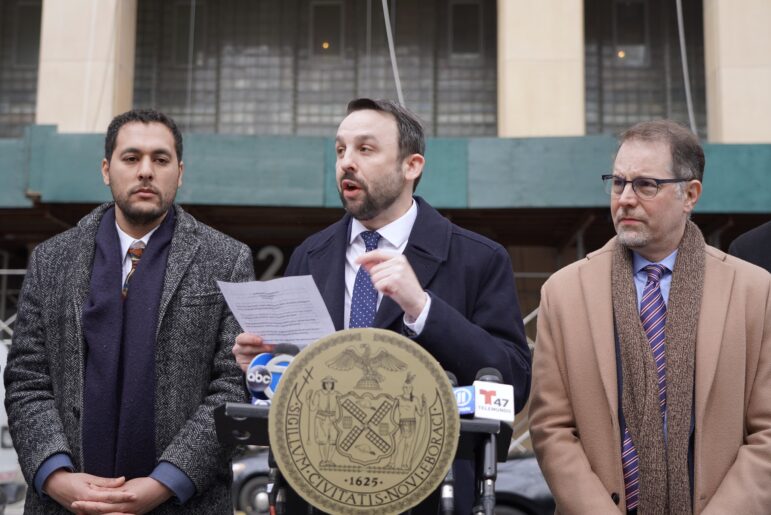“All You Can Eat: How Hungry Is America?” by Joel Berg, Seven Stories Press, $22.95.
If there’s anyone in America who knows more about the politics of hunger than Joel Berg, they’re well hidden. First as a top staffer in the Agriculture Department under Bill Clinton, and currently as director of the New York City Coalition Against Hunger, Berg has been a tireless advocate for ensuring that all people have enough to eat.
After years of lecturing mostly to an audience of perplexed city officials, Berg has now set down his knowledge in book form with “All You Can Eat: How Hungry Is America?” Though dense with useful statistics, Berg’s trademark good-natured snarkiness makes this an eminently readable book that lays out the dimensions of the growing hunger epidemic, and what can be done about it.
The population of Americans that goes short of adequate food is divided into two categories, explains Berg. About 11 million people, as of 2006, officially suffered from “hunger” at some point during the year, defined as having at least one stretch where they didn’t have enough to eat. The “food insecure,” numbering more than 35 million, may have been free of outright hunger pangs, but reported skimping on portions, substituting cheaper but less nutritious options, or otherwise showing signs of uncertainty about where their next meal was coming from. (To make matters still more confusing, the Bush Administration dropped the word “hunger” from the USDA’s vocabulary, substituting “very low food security.”) And the actual numbers are likely even higher, since the USDA’s hunger surveys omit, among others, homeless people.
~
While Berg finds these numbers unacceptable, he notes that two-thirds of the nation’s poor avoid food insecurity thanks to the federal food-stamp program, plus the nation’s network of soup kitchens and food pantries. But though Berg may be director of a coalition of emergency food providers, he seems like he’d be happy enough to see them put out of business by an expansion of federal programs. “Trying to end hunger with food drives,” he concludes, “is like trying to fill the Grand Canyon with a teaspoon.”
Yet 45 percent of the nation’s hungry get no federal food aid, in most cases either because they are ineligible or because they believe they are. Berg rails against the “Kafkaesque nightmare” of a food stamp system that, in New York, allows someone to be denied benefits for, among other things, owning more than one funeral plot. Getting USDA farm subsidies, he notes, generally requires less paperwork than getting USDA food stamps. Yet apparently no one has suggested subjecting farmers to “finger imaging,” as food stamp applicants are to root out fraud.
“All You Can Eat” also delves into the history of hunger programs, from the first establishment of a Food Stamp Program under FDR in 1938, to campaigns of the 1960s such as the Poor People’s March that Martin Luther King, Jr. was helping organize at the time of his death to, crucially, the 1968 CBS documentary “Hunger in America,” which eventually led to President Nixon establishing the modern food stamp and WIC (Women, Infants and Children) nutrition programs. The book tackles broader issues of poverty as well, assessing the results of welfare reform (not so hot, though Berg agrees with his old boss that on balance it was worthwhile to get more poor people into the workforce), and surveying New York’s role as the “shrinking middle-class capital of America.” Oil magnate David Koch, for example, the city’s richest resident, gets called out for having a net worth that’s five times the combined income of all 1.7 million New Yorkers below the official poverty line.
All this is a problem, Berg argues, not just for the poor themselves, but for the nation as a whole. “Poverty in America hurts everyone,” he asserts, presenting data showing that hunger erodes economic productivity and leads to poor health and mental illness, with resulting costs for the greater society. One study he cites estimated that the average U.S. citizen’s annual “hunger bill” is about $300.
Berg is unparalleled when it comes to marshalling statistics, but “All You Can Eat” is notably skimpy on first-hand reports of hunger. While there’s a chapter on Berg’s participation in a campaign to get elected officials and advocates to live on a food stamp budget – “The week of the experiment, I felt like Godzilla. I was ready to eat chunks of concrete,” he says – there’s precious little from those who are actually hungry day in and day out. The best firsthand quote might be from Daily News reporter Heidi Evans, who after her own attempts at living on a minimum-wage income concluded, “It is impossible to live on $206 a week, or $892 a month, if you like living indoors.”
Following the book’s first part, “The Problem,” comes part two, “The Solution,” which lays out a panoply of policy ideas to end hunger and at least put a dent in poverty as well: a “nutrition safety net” to eliminate hunger, which Berg estimates could be accomplished for one-quarter the ongoing cost of the Iraq War; free school breakfasts and lunches to all, including in summer; equipping food pantries to provide social services to their customers (because that’s where the need is; Berg cites Willie Sutton’s explanation that he robbed banks because “that’s where the money is”); and a higher minimum wage and better access to education to ensure that more people can feed themselves without government help. These 351 pages – including appendices, notes and an index – certainly don’t lack for ambition. Any book that includes a section called “Here It Is: The Plan to End Domestic Hunger” deserves points for chutzpah.
Berg has a quandary here, though. As he says at the book’s outset: “Hunger is a no-brainer. … Everyone is against hunger in America. Actually, you’d be hard-pressed to find anyone in America who says they’re ‘for’ hunger.” If so, though, how come it’s so persistent, even after close to a century of hunger-fighting campaigns?
There’s no real answer to be found here, save for swipes at “politics” and certain politicians, not to mention folks like famed chef and “slow food” advocate Alice Waters, who earns Berg’s wrath for suggesting that if people can’t afford organic meals, they forgo that “third pair of Nike shoes.” Larger questions go unanswered: Is it really in the self-interest of large employers to ensure food benefits to those who they’re simultaneously trying to lure into low-paying jobs? If a food safety net was provided to all those living in or near poverty, what would be the effect of the “benefit cliff” that families would hit once they earned enough income to no longer be eligible? And, perhaps most important, even if Americans deplore hunger, do they have ideological objections to providing free food to everyone in need? For someone who was privy to the inner workings of a presidential administration’s hunger policies for eight years, Berg seems curiously unable to provide analysis about why his solutions aren’t being implemented.
Though maybe, at this particular political moment, we don’t need analysis so much as a sales pitch. Berg begins his solutions section by declaring: “A very good president put the U.S. on a trajectory to the moon. A truly great president would end hunger in America.” While “All You Can Eat” went to press before the results of the presidential election were recorded, it’s no secret whose potential he was invoking when he wrote that.
For more on the book, click here.








